On The Grounds Of Palmer Ranch
We have planted many different types of flora on the Palmer Ranch grounds to enhance the beauty of our surroundings. Listed below are the different types of Palms, Plants & Trees you will find in Palmer Ranch.
We have planted many different types of flora on the Palmer Ranch grounds to enhance the beauty of our surroundings. Listed below are the different types of Palms, Plants & Trees you will find in Palmer Ranch.
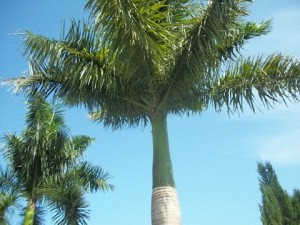
The Royal Palm’s standout feature is the dark green pinnate, or feather- like, fronds emerging from the bright green crownshaft. The glossy green trunk changes dramatically below the palm fronds to a smooth, light gray trunk that continues down to a budge at the roots. Remarkably, the Royal Palm which does well during tropical days and cool winter nights, not only tolerates, but seems to thrive in the inferior soil and inadequate drainage of urban environments where other trees tend to do poorly.
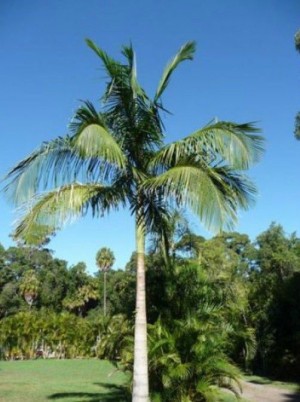
The considerably cold-hardy Piccabeen Palm features long, sweeping palm fronds atop a smooth, gray trunk and a parrot-green crownshaft. Although it's considered moderately drought-tolerant once established, a piccabeen will also thrive with regular watering. The aging brown fronds of this East Australian native palm fall off without being trimmed which reduces the need for maintenance.
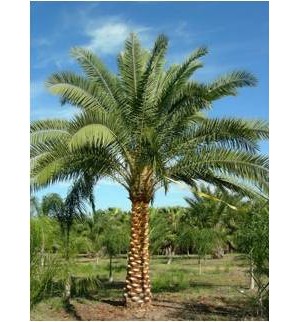
This native of India is very cold hardy and is chosen for its drought tolerance and fairly slow growth. The Sylvestrie Palm has a solitary robust trunk with the typical diamond-shaped pattern created by leaf scars and is swollen at the base. Sometimes called the Indian Date Palm, it requires some trimming of old dead leaves which otherwise tend to make a “skirt”. Without a crownshaft, silvery blue-green fronds emerge from the patterned trunk having sharp spines at the base of large pinnate, feather-shaped, leaves.
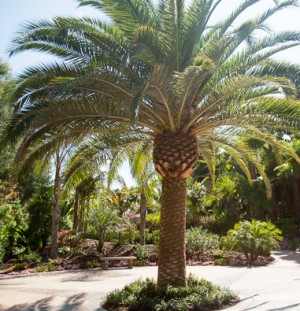
In spite of its tropical look and its propensity for a sunny location, the Canary Island Date Palm is one of the best cold hardy palms. This native of North Africa and the Canary Islands has a gray-brown stout trunk that is topped with a huge crown of stiff large dark green leaves. The arching feather-like fronds have stems that sport 2-3 inch sharp spines. It is not a self-cleaning palm, so dead leaves need to be pruned to maintain its beautiful appearance. When pruned correctly, the bottom of the crown has a so-called nut that looks like a pineapple, hence it is sometimes called a Pineapple Palm. Ferns often germinate in the "pineapple" part as the trunk forms, adding to the ornamental look.
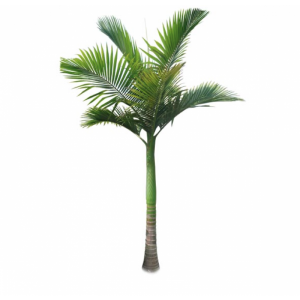
This beautiful and elegant native of Queensland, Australia has a solitary, tall, smooth, light gray trunk ringed with leaf scars that is often enlarged at the base. The Alexander Palm has a beautiful crown of long self-cleaning pinnate fronds with leaves that are bright green on top and silver-white on the bottom. These leaves can grow up to 7 feet long and arch vertically giving the tree its graceful, elegant appearance. This beautiful ornamental palm enjoys humidity and plenty of water, but is also cold hardy.
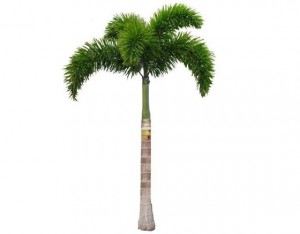
The enchanting Foxtail Palm is extremely popular for its perfect proportions and full, rounded fronds. The foxtail is a reasonably salt- tolerant palm and is considered self-cleaning, as old fronds fall off by themselves, and is available in single or multi-trunk specimens. Its smooth gray trunk is topped with a bright green crownshaft and big tufted fronds that resemble the bushy tail of a fox. These South Florida palms like plenty of sunshine and they're moderately drought-tolerant once established, although a regular watering is ideal.
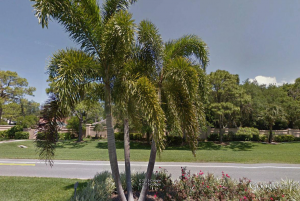
The foxtail palm is a single trunk pinnate leafed palm. It is propagated by seed which is characteristic of a “solitary” trunk palm. Triple trunks are used to give more mass to a planting, and for a fuller canopy of fronds producing shade in a limited space. Foxtail palms are often planted in groups for a naturalized look rather than singly or in matching pairs or rows. Triple foxtail palms are single-trunked trees that are intentionally grown together, but are not “clustering palms” which grow from the same base.
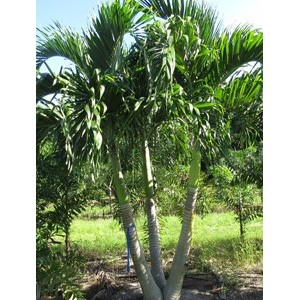
Showy, highly ornamental palm that works beautifully in small landscape areas. The Christmas Palm is self-cleaning, meaning the spent fronds just fall off by themselves, and is a big low-maintenance plus. Christmas Palms are pretty much pest-free.
It looks like a miniature royal palm, with its green crown shaft, gray trunk and long full fronds. Christmas palms make good focal points in small tropical gardens and, when taller and more mature, they can become an elegant statement palm. As it matures, the adonidia will bloom with white flowers and then red berries (seeds) around Christmas time.
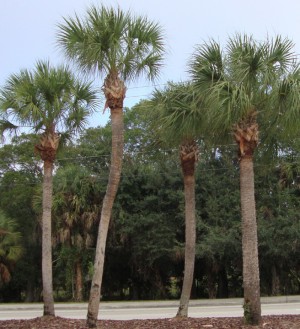
The Cabbage Palm was designated our state tree by Florida legislature in 1953. This native palm grows throughout the state and is one of the most wind resistant trees in any landscape. The trunk can be straight or curved and has a dense 10 to 15 foot diameter crown of palmate leaves at the top. In the summer a creamy white inflorescence appears followed by small, shiny, green to black fruits that serve as food for many animals. Cabbage Palms are hardy and will grow well in partial shade or full sun.
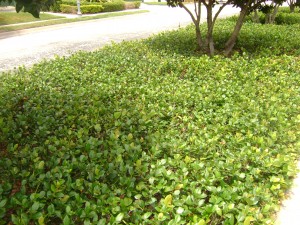
Asiatic jasmine has been grown as a ground cover in Florida landscapes for decades. It’s not a grass, but a multi-stem, vine-like woody plant. Asiatic jasmine is a true ground cover, and its numerous horizontal stems and leaves eventually blanket the ground forming a thick mat. Minima jasmine has few pest or disease problems, and rarely, if ever, requires pesticides. Once established, it requires no irrigation with normal rainfall.
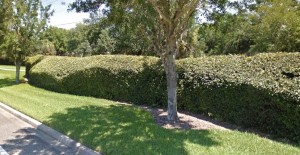
Elaeagnus is a resilient evergreen shrub with pendent flowers that bloom during October and November which provide a delightful gardenia-like perfume. Its handsome foliage is a lustrous green above, dull and silvery dotted with brown below. The brown fruit of the elaeagnus ripens to red in autumn. This hardy grower thrives in the sun or shade, and in all types of soil. Elaeagnus is considered a weed by some, but its resilience makes it an ideal candidate for hedges, screening, and bank plantings.
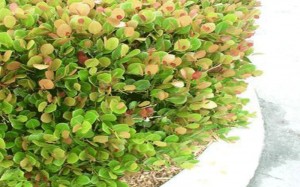
Cocoplum, a South Florida native, is an outstanding evergreen plant with a "beachy" look, producing an edible plum which many creatures enjoy. Terrific as a hedge or privacy plants, these multi-stemmed, woody shrubscan grow to about 15 feet - though most of the time they're kept trimmed to around 4 feet. The cocoplum takes some effort to get established, but once it is growing well it is an easy-care plant that is salt-tolerant and needs little irrigation. This dense evergreen with shiny, leathery leaves can be kept more manicured for a formal look or left to grow in its naturally pretty rounded shape in a casual landscape style.
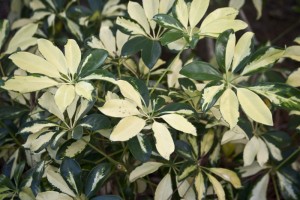
The arboricola is a sturdy, long-lived plant that requires only minimal maintenance, is a dwarf version of the umbrella tree plant. These hardy plants rarely flower as foliage plants, but may produce clusters of round orange-red berries if left unpruned in the landscape. Tropical evergreen plants from Taiwan, the arboricola grow complete with branch roots that give them a small Banyan tree look. Outdoors pest problems are rare for these drought and heat tolerant plants, and while a frost may cause leaf drop, they will come back when the temperature is once again warm. Schefflera ‘Trinette’ has bright yellow and green foliage and grows well in sun to part shade.
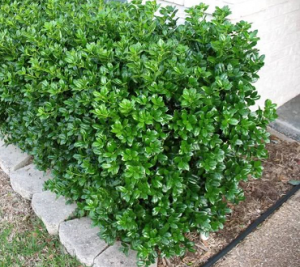
Commonly called Chinese holly, Burford holly is an evergreen shrub. Although usually planted in a grouping as a hedge or border and sheared evenly, the lower branches on this versatile plant may be removed on large specimens to achieve a tree form. Burford hollies are quite distinguished with glossy, stiff leaves with a sharp point at the tip that often develop two spines on the side. Not requiring pollination, it produces long lasting large red berries every year. The Burford holly is rather hardy and can grow to be 20 feet tall.
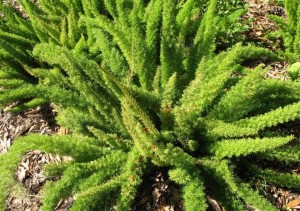
Foxtail ferns are unusual and attractive evergreen flowering plants. Also called Myers Ferns, they are not really ferns, as they reproduce from seeds and not from spores. Multiple plants clumping together make their appearance similar to that of ferns, but in truth are a member of the lily family. They are spreading perennial herbs that have a fine texture with a stiff, upright growth. The structures that most consider to be the leaves of this plant are actually narrow, light green, leaf-like branchlets often armed with sharp spines, however, the actual leaves of this fern are scale-like and inconspicuous. The foxtail fern has flowers that are white or pale pink which produce bright red berries.
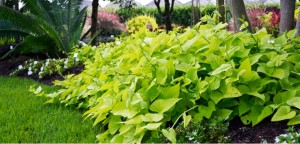
The leaves of the ornamental sweet potato vine may be purple, bronze, yellow-green or variegated with white and pink. This fast growing, twining vine is a variety of the edible sweet potatoes that are selected for their colorful foliage, but are not tasty like their green leafed cousins. These showy plants bloom late in the season with the appearance of tubular, fairly large flowers which are similar to morning glories. Usually they are not particularly noticeable, though, because the foliage claims most of the attention. The sweet potato vine is happiest in sun to partial sun where it gets a bit of afternoon shade.
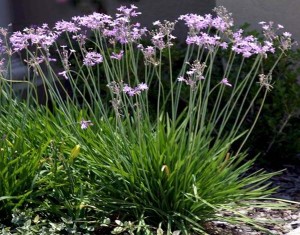
Society garlic is a perennial with narrow, grayish green grass-like leaves and large clusters of lavender or lilac flowers. The leaves grow straight up out of a bulb on an underground rhizome which produces a single scape, or flowering stalk, topped by a large flower cluster called an umbel having lilac-pink flowers with six points. The leaves and rhizomes of society garlic smell like garlic, but the dainty little flowers are sweet, smelling like hyacinths.
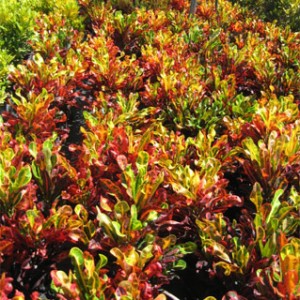
The Mammy Croton a member of a family of evergreen shrubs that have large, leathery, shiny leaves. The cultivated garden crotons are usually smaller and come in an amazing diversity of leaf shapes and colors having tiny inconspicuous star-shaped yellow flowers. One of the smallest croton plants, the Mammy Croton, is a red variety with bright red, yellow and green leaves that can be maintained about 2 to 2-1/2 feet. These gorgeous shrubs can jazz up an all-green landscape or work well with flowering shrubs. A benefit of mixing crotons with flowering shrubs is the consistency of color in the landscape, even while other plants are not in bloom.
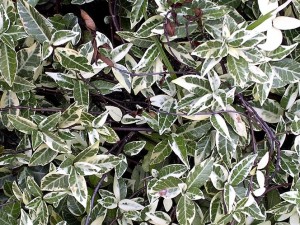
Confederate jasmine grows as a neat tangle of slender wiry stems covered with thick glossy evergreen leaves that are long, oval shaped, and pointed at both ends. During April and May the plant goes two-tone as it flushes light green with new growth and tiny white blossoms appear. Pest-free, easy to maintain, drought resistant and heavenly fragrant, Confederate jasmine is probably the South's favorite flowering vine. It makes a good groundcover for large areas where it will scramble all over itself and may be sheared to maintain a consistent height. This beautiful evergreen vine is not a "true" jasmine and is not native to the American South - it comes from China.
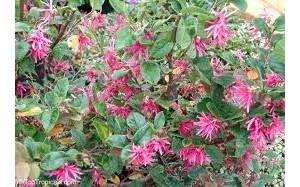
Loropetalum chinense, also called Chinese fringe flower, is a finely textured evergreen shrub that spreads as it grows with branches arranged in horizontal layers. When vertical stems are periodically removed loropetalum makes an effective large scale groundcover. The flowers are arranged in small clusters with each having 4 narrow strap-like petals that droop downward. Once becoming established in a well-drained, partially shaded location, this pretty pink plant is very hardy for our area and can be considered drought tolerant.
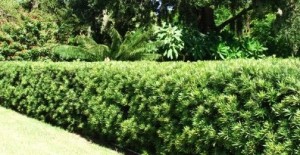
With dense foliage on its lower limbs which reach the ground and neat, dark green, evergreen leaves, Podocarpus is very popular as a screen or hedge. It does well in any area of South Florida and can reach 40 to 50 feet in height when not trimmed. Podocarpus is hardy and will grow well in sun or shade, however, in a shadier spot the color will look deeper and richer and the plants will grow more slowly. In the spring it produces tiny, inconspicuous flowers that are followed by fleshy, purple, small, edible fruits on female trees which are quite attractive to birds. While beautiful as a hedge, Podocarpus is quite attractive as a tree with the lower branches removed.
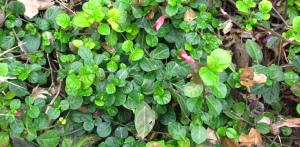
Coral Creeper is a tough, exotic plant that stays green throughout the winter. Popular in Southern Florida, this vine-like plant can quickly cover bare ground or climb to about 6 feet on a tree trunk or wall. Often found sprawling on the ground under a shade tree, this evergreen plant with small rounded soft glossy leaves and salmon colored flowers looks similar to the dwarf azalea. The blooms are tubular, fairly large and appear primarily from late summer through fall. The Coral Creeper prefers being planted in partial shade and unlike the azalea, can send out new stems that become rooted on their own.
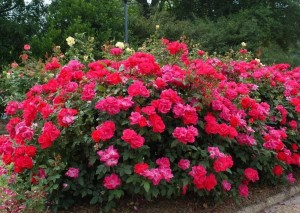
A Florida favorite, the Knock Out Rose is treasured for its ability to produce high numbers of flowers practically year round in the warm, sunny climate. Thriving in fertile, well-draining soil with ample sunlight these disease and pest resistant roses flourish with style. These naturally compact shrubs require less fussing over than other traditional roses, but with some attention several knockout rose bushes blooming is a beautiful sight.
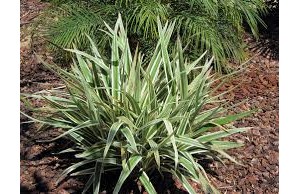
This drought-resistant perennial produces late-summer flowers and is grown primarily for its variegated strappy foliage. Although the flax lily does well when planted in shady locations, the more sun the better for keeping the variegation at its peak. In early summer, it sends up branching clusters of white, light blue, or violet star-shaped flowers followed by shiny dark turquoise blue berries lasting from fall into winter, however, its handsome green leaves with contrasting yellow stripes will brighten the landscape year-round.
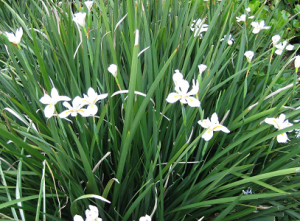
The White African Iris is a perennial evergreen with white blooms and narrow, dark leaves in a loose fan. The flowers are dainty and each bloom lasts a single morning, however, new flowers open continually on a wiry, arching stems from spring through to summer. This beautiful plant makes a gorgeous ground cover under large, tall trees and is often grown in borders in light shady areas
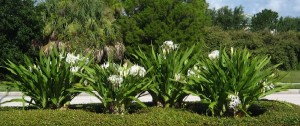
Crinum lilies are a hallmark of Florida landscaping producing fragrant flowers all year, especially throughout the long summery stretch. The blooms sit atop tall stalks and come in a range of whites and pinks surrounded by sword-like, evergreen foliage. They work so well in the warm climate because of their easygoing nature and sometimes grow for years with little or no care, however, as with other easy-care plants, they thrive with a modest amount of attention.
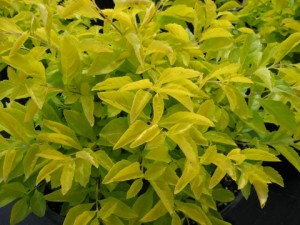
Gold Mound Duranta is also known by the common names of Golden dewdrop, Pigeon berry & Skyflower. This tropical native is attractive to butterflies and birds and has the ability to thrive in heat and humidity. Duranta is commonly grown as a border or low hedge shrub, the new growth is chartreuse and provides a nice contrast amid darker greens in the landscape. This multi stemmed shrub, prefers warm to hot weather and once established is relatively easy to maintain. This plant grows slowly and rarely flowers. The occasional flowers range from lavender and blue to white producing showy clusters of golden yellow fruit that may be poisonous if ingested.
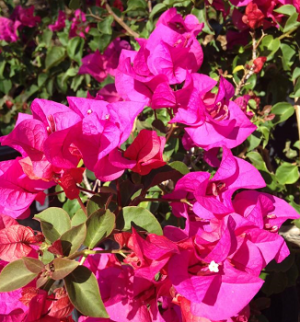
Butterflies and humming birds are attracted to the garishly bright magenta flower-like leaves called bracts of the ‘Helen Johnson’ Bougainvillea. The true flowers of this sun loving evergreen shrub are small and tubular. Large clusters of the inconspicuous flowers and their papery petal-leaves emerge at the branch tips of this small, but showy plant. Shiny hunter green foliage on exquisite arching branches lend balance to this hardy landscaping favorite.
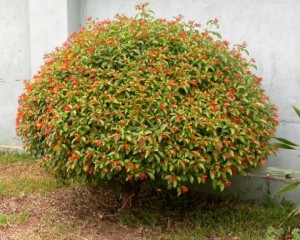
Birds, butterflies and hummingbirds love this Florida native plant. The bright red-orange tubular flowers appear on and off all year, more in warmer weather, and in cooler months some of the slightly fuzzy leaves will turn bright red. The bush also produces attractive black berries which attract birds.
Firebush has an airy, informal, cottage-garden appeal and looks best (and flowers most) when left to form a natural shape rather than using hedge trimmers to keep it more manicured.
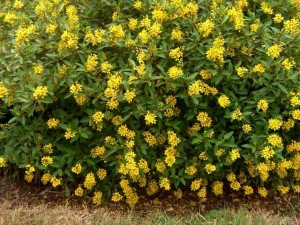
Pretty as a picture, sweet-scented Thryallis flowers on and off all year with informal, cottage-garden appeal. Gracilis means graceful and that's a perfect description of this lovely plant. One of the easiest care yellow-flowering shrubs for South Florida, Thryallis blooms with abandon most of the year.
As fragrant shrubs go, this one won't overwhelm you with heavy fragrance...the smell is subtle and suitable for mass plantings. The fragrance of some plants, such as night-blooming jasmine, can be too much to take with multiple plants. Growing in light options from full sun to partial shade means this plant is versatile as well as easy care.
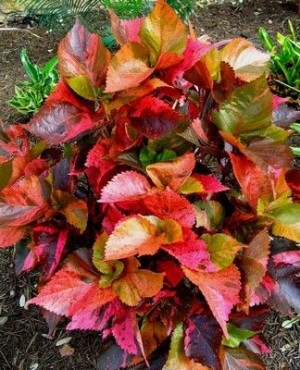
One of the prettiest South Florida shrubs is the Copper Plant - or "Copperleaf" - with its striking, brightly-colored leaves. Each leaf is different, like a miniature masterpiece of nature. Copperleaf plants like full sun to part shade - and the more sun, the brighter the leaf color.
These shrubs do flower but with narrow, dangling, fuzzy blooms (called "catkins") similar in color to the foliage so the blossoms are all but invisible. A sunny spot will bring out the best color, though coppers will grow in partial shade.
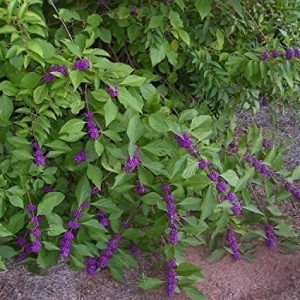
Beautyberry is a fast growing native perennial shrub; growing five to eight feet tall and almost as wide with drooping branches. The underside of the leaves may be covered with wooly like hairs. In late spring to early summer, inconspicuous flowers of blue, violet, pink, or white are arranged in clusters on the stems between the leaves. In August or September, clusters of small purple to blue berries or drupes encircle the woody stems. Each small berry in the cluster contains two to four seeds about 1/16 in. long.
This plant is distributed throughout the southeastern United States from Texas and Oklahoma east to Maryland. American Beautyberry is found in woods, particularly on moist areas under open pine canopies, thickets, right of ways, and fence rows. It is adapted to moist, loam, sandy or shallow upland sites and a wide pH range.
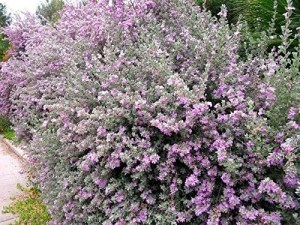
Handsome and hardy, Texas Sage is an outstanding South Florida landscape choice with its silvery foliage, purple flowers and drought-tolerant nature. The lavender to purple blossoms appear on and off all year amidst small, soft, silver or gray-green leaves.
Though not a true sage, this shrub is easy care and doesn't like to be fussed over. In fact, this is one plant where too much care - water, fertilizer, trimming - can actually be detrimental to its health. A native of Texas and the arid southwest, Texas Sage is called the barometer plant there, because as soon as the humidity begins to rise after very dry weather, this shrub bursts into bloom. This is an excellent plant for those areas so dusty and dry nothing wants to grow there. The silver foliage - not to mention the pretty flowers - makes it stand out in a landscape of green-green-green.
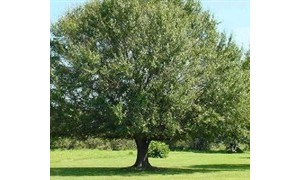
The Laurel Oak is a rapid-growing tree that lives approximately 50 years. It is one of the most popular landscape trees in Florida because it produces a heavy shade when planted close to houses and reduces air conditioning costs during the summer. With small simple leaves that fall in the spring when the new leaves are just emerging, Laurel Oaks provide shade most of the year. Brownish black acorns are produced on the trees in great profusion during the fall months. Despite their bitter kernel, they are eaten by deer, squirrels and birds. The Laurel Oak is also popular as an ornamental tree, with its pleasing symmetry providing both form and function.
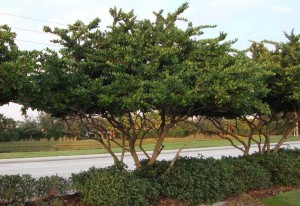
Although often used as a shrub or hedge the Ligustrum solos very nicely as a tree. The curved multiple trunks with glossy evergreen leaves on the upright, spreading branches create an interesting focus in the landscape. Standing as tall as 12 feet and often considerably wider, the mature Ligustrum can grow to 25 feet across. Small, white flowers appear during spring. The unpleasant smelling blooms are followed by abundant blue-black berries that are popular with birds.
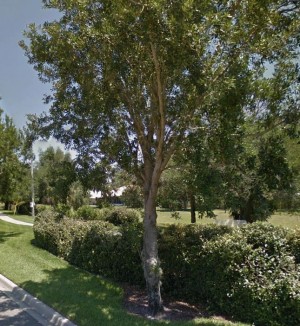
The Cathedral Live Oak Tree was named because of the overall shape of the tree, that of a church steeple. It is a cultivar which means it was cloned from a mother tree with the same DNA so as to copy the dense and upper structure of the tree. The Cathedral Live Oak is native to the Southeastern United States, is easy to grow and requires no extra care once established. This evergreen shade tree with its well-spaced branching complimented by dense, dark green foliage is perfect for any place where consistency, privacy and shade are desired in the landscape.
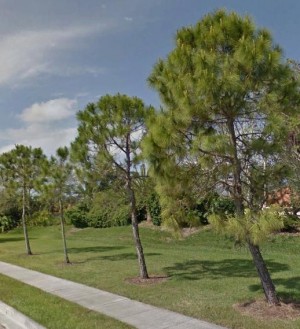
The Slash Pine Tree is a hardy native conifer that creates a natural bird sanctuary. These trees that grow as tall as 80 feet shelter birds from predators, with owls, woodpeckers, eagles and egrets all making their homes amid the branches. With luxurious long soft needles, these shade trees provide more open foliage than a broadleaf tree, so light can filter down to nearby plants making it ideal for many shrubs and groundcovers. The Slash Pine is happy in low hammocks, sloughs, along streams and in preserve areas where its Pine seeds are a great food source for squirrels and other animals.
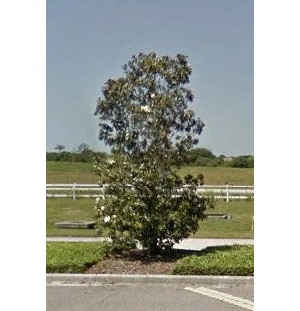
‘Little Gem’ is a dwarf Magnolia with leathery green and brown leaves that produces large, cream to white, cup-shaped flowers which are showy and fragrant. Little Gems bloom during spring and throughout the summer adding a very elegant style to the landscape. Also known as the dwarf Southern magnolia, the beautiful blooms give way to cone clusters from late summer to early fall that release small red-coated seeds. ‘Little Gem’ magnolia is very hardy and does well in full sun and hot conditions, making them a perfect choice for the sometimes challenging Florida landscape.
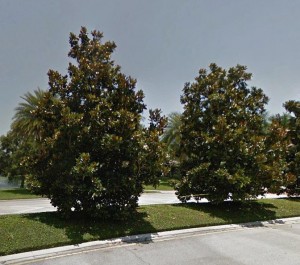
The Southern Magnolia is one of the most beautiful native evergreen trees with its straight trunk, conical crown, and very fragrant, very large, white flowers. It can grow to be 50 feet tall or more with a dense growth of smooth, leathery leaves that are shiny on top and rusty below. Fragrant, creamy-white flowers about 8 inches across appear on the ends of thick, tough stems all over the tree. The blossoms last only two to three days before falling off, but continue to appear throughout the summer and into fall. This hardy tree enjoys the warm Florida climate.
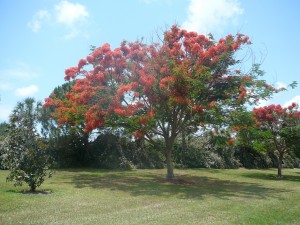
Majestic size and fabulous color make the Royal Poinciana Tree a classic symbol of living in South Florida. This lovely tree is decorated in late spring through midsummer with rich orange-red flowers on its umbrella-shaped crown of fine textured leaves. Poinciana trees are fast growing, reaching heights of 40 to 50 feet. This magnificent tree can grow even wider than its height.
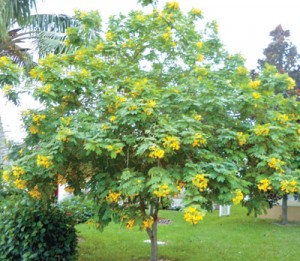
The Cassia surattensis grows quickly to 12 to 15 feet. Preferring full sun, the cassia tree blooms in spring and fall producing masses of bright gold flower clusters appear on almost every branch, as well as, pea-like pods containing 3 to 5 seeds. This butterfly attractor sports pretty, bright green feather-like foliage in a gently rounded crown year round.
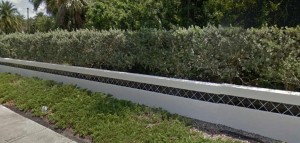
The low-branching, multi-trunked, silver buttonwood is instantly recognizable by its unusual appearance. The Florida favorite has beautiful silvery leaves due to silky hairs which cover the leaf surface. The inconspicuous flowers of the striking evergreen tree are white, yellow or pale green and later mature into clusters of small, button-like reddish brown fruits. This plant's unusual color contrasts beautifully with all the green in a landscape. Although it is often planted as a multi-trunked ornamental shrub, since the plant grows in a vase shape - wider at the top - the silver buttonwood is often cultivated as a tree, and can grow to a height of 50 feet. This Florida native is one tough customer and flourishes in any environment as long as the temperature is above freezing.

Sometimes called the "Lilac of the South," the Crape myrtle with its abundance of warm weather flowers has become a favorite of Southern landscapers. These deciduous shrubs or small trees produce cascading clusters of flowers called panicles at the tips of their branches from late spring all the way until fall. This hardy plant flourishes in full sun with plenty of breathing room. Even during the Florida winter the Crape myrtle adds interest to the countryside with the gnarled shape of its multiple trunks.
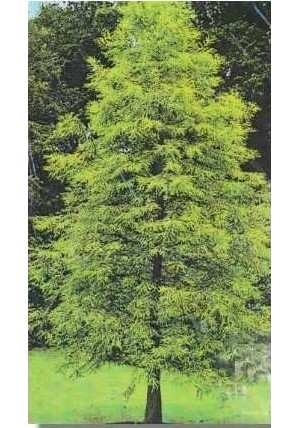
A tree that likes growing near moving water and even swamps, the majestic Bald Cypress Tree has feathery branchlets of soft needles and tiny one inch cones. It doesn't develop as broad a canopy as other shade trees, although it can grow to 40 or 50 feet. When planted near water the Bald Cypress grows knobby roots out of the ground around the tree called “knees” and is even more unusual because it is a deciduous conifer and loses its leaves, hence it is “bald.”
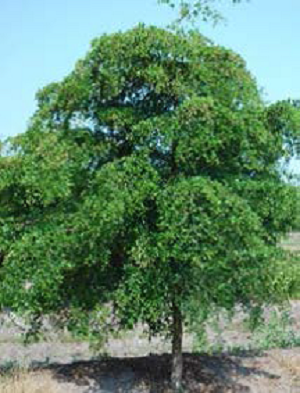
The Exquisite Shady Ladytree, commonly known as the black olive, with its lush layers if tiny leaves is quite beautiful. Rather bushy,its dense foliage makes it an excellent tree for shade, yet it is relatively easy to maintain. The Shady Lady can reach astounding heights of up to 50 feetand features a frosting of small yellow flowers while blooming. the "black olive" name can be misleading, as this tree is not actually an olive tree and does not produce the edible black olive fruit. This sturdy and stunning tree loves the hours of sunlight provided by the Florida climate.

The unusual Frangipani Tree, with large leaves and bright summer blooms, can turn a ho-hum landscape into an exotic, tropical showplace. Often called Plumeria Tree (its scientific name), the Frangipani is the proverbial Ugly Duckling in winter - losing its foliage and leaving you with an oddly-shaped bunch of sticks in the ground.
Luckily winters are short here in South Florida, though many a newcomer to South Florida has been known to pull out a Frangipani Tree in winter, thinking it's dead. In spring, the Frangipani is transformed into the beautiful swan...new leaves appear, followed by late spring/early summer blossoms in gorgeous colors. The plant flowers its little heart out until fall when weather begins to cool down.
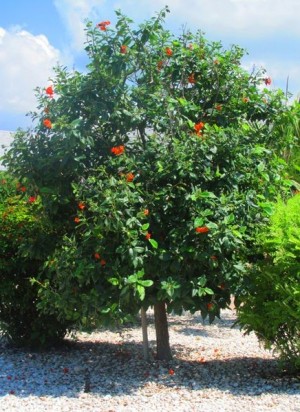
Believed to be a native of the Florida Keys, the lovely Orange Geiger Tree blooms during warm weather with frilly flower clusters in vivid orange, yellow or white. The Orange Geiger (Cordia sebestena) is the most well-known, with showy, deep orange flowers that contrast nicely against the tree's coarse green leaves. Many consider it the most beautiful of Florida native trees. The orange variety is a hummingbird attracter.
The Geiger is a low-maintenance tree as long as it's planted in a frost-free area sheltered from winter winds. Its high salt tolerance makes it a perfect small flowering tree for homes on or near the beach.
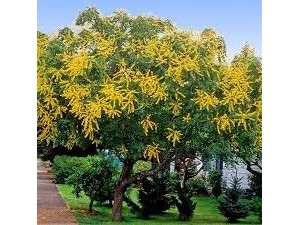
This Asian native was introduced to North America in 1763, so it was a familiar sight even before the Revolution. It tolerates a high range of conditions because it isn't terribly picky about soil and tolerates drought well once it is established. It likes a sunny spot, but will bloom with only 6 hours of direct sun each day. However, the best show is when the tree grows in moderately fertile ground in full sun.
The Golden Raintree was chosen for its long-lasting display of yellow blooms, orange-yellow fall color, attractive bark, tough, rugged, easy care, fast growing once established, tolerates urban pollution, muffles traffic noise, extremely drought tolerant, umbrella shaped canopy looks tidy and one of the best honeybee trees
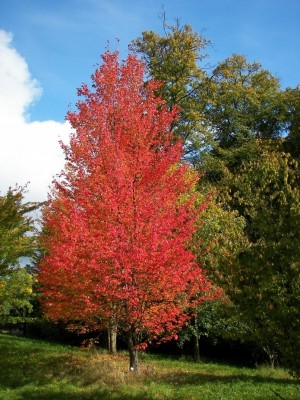
The pretty Florida Red Maple Tree is one of the few trees in Florida with a showy color change when winter weather arrives. It takes full to part sun but will also live in partial shade.
Maples are deciduous, losing their leaves in winter. They provide a burst of stunning color before they drop leaves. These are cold hardy trees, fine anywhere in South Florida and actually prefer cooler areas. The Maple can handle "wet feet" - areas that stay moist after heavy rains. It also does very well planted by a pond.
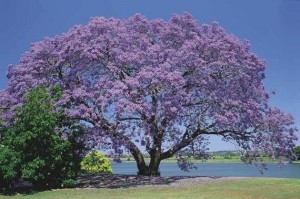
One of the most beautiful spring flowering trees, the Jacaranda blossoms in April or May after the bare branches of this briefly deciduous tree begin sprouting new growth. Jacarandas take a while to flower - if you plant from grafted cuttings (what nurseries sell) your tree will begin flowering when it's between 5 to 7 years old. Jacaranda’s prefer a full to partial sun location with plenty of elbow room.
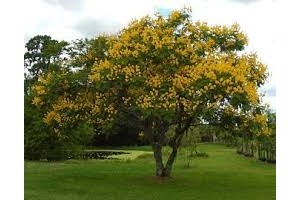
Very beautiful, briefly deciduous. The entire tree blooms with yellow flowers in early summer. Yellow Jacaranda Trees are fast growers that reach 25 to 50 foot high and just as wide. They work great as a stand-alone specimen tree or as a large anchor for a garden bed. The Jacaranda trees are excellent nectar producing trees which attracts birds, bees and butterflies.
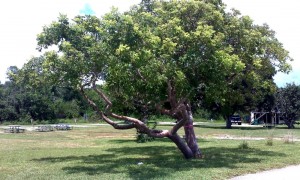
Native to South Florida and the tropical offshore islands, Gumbo-Limbo is a large semi-evergreen tree. It can reach sixty feet in height. The soft, light-weight, and easily carved wood of gumbo-limbo was used for making carousel horses before the advent of molded plastics.
The trunk and branches are thick and are covered with resinous, smooth, peeling coppery-colored bark with an attractive, shiny, freshly-varnished appearance. The Gumbo-Limbo is often referred to as the "tourist tree" because the tree's bark is red and peeling, like the skin of a sun burnt tourist. Gumbo-Limbo is also considered one of the most wind-tolerant trees. This attractive tree is an excellent choice—for South Florida landscapes